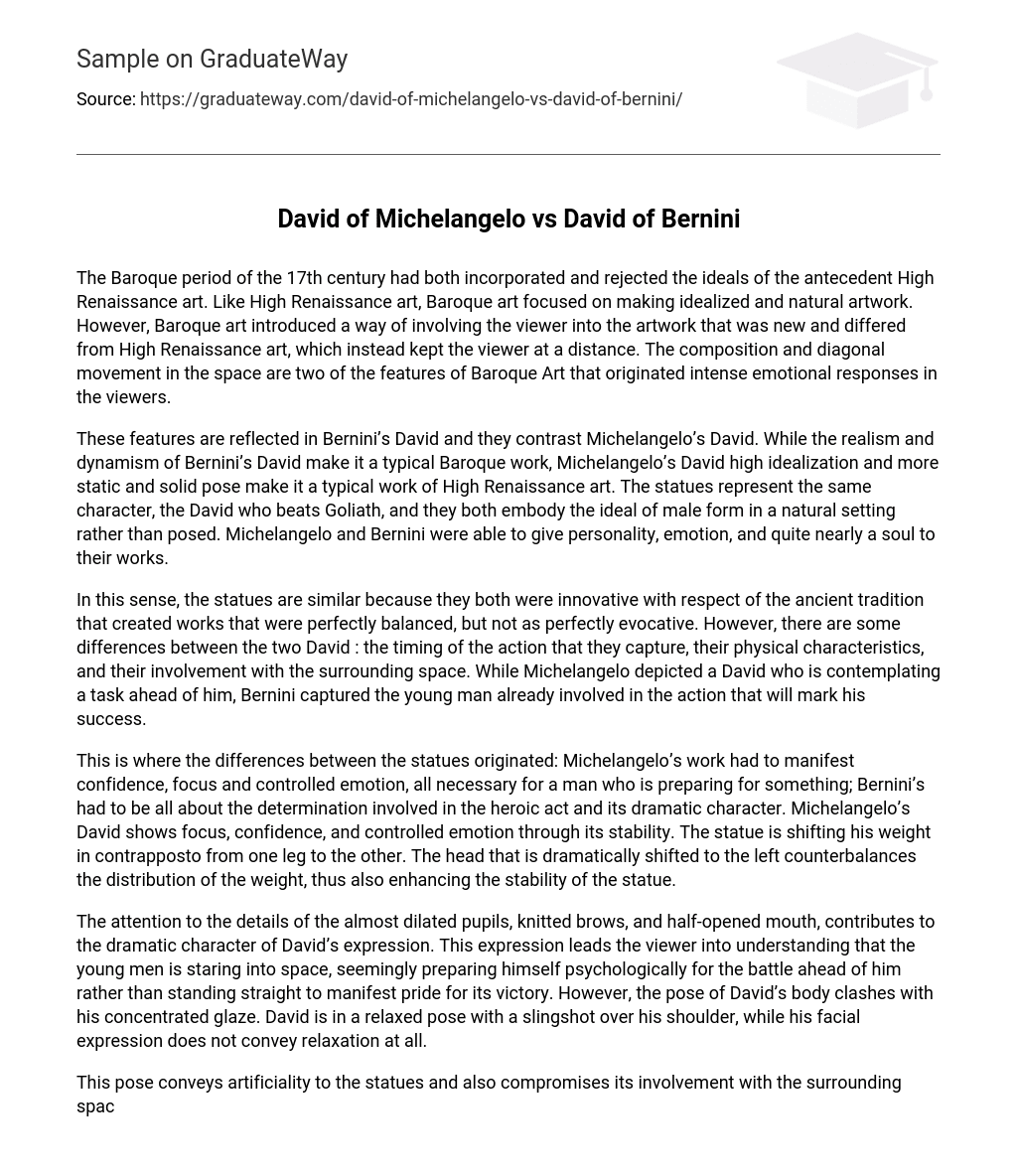The Baroque period of the 17th century embraced and rejected the principles of previous High Renaissance art. Similar to the High Renaissance, Baroque art aimed to create idealized and realistic artwork. However, Baroque art uniquely engaged the viewer, diverging from the High Renaissance’s more detached approach. The intense emotional reactions elicited from viewers can primarily be attributed to the composition and diagonal movement found in Baroque Art.
Both Bernini’s David and Michelangelo’s David depict the same character, David defeating Goliath. However, they differ in style and art movement. Bernini’s David, with its realistic portrayal and dynamic pose, exemplifies the characteristics of Baroque art. On the other hand, Michelangelo’s David displays high idealization and a more static and solid stance, which are typical of High Renaissance art. Despite these differences, both sculptures convey the ideal male form in a natural setting rather than in a contrived pose. Notably, both artists managed to infuse their works with personality, emotion, and an almost tangible essence.
Both statues, Michelangelo’s David and Bernini’s David, were innovative within the context of ancient tradition. They both deviated from the perfectly balanced but less evocative works that were common during that time. However, there are distinctions between the two sculptures. Firstly, they differ in the moment of action that they represent. Michelangelo’s David portrays a figure contemplating a future task, while Bernini’s David depicts a young man already engaged in the action that will lead to his triumph. Secondly, the physical characteristics of the statues set them apart. Lastly, their relationship with the surrounding space varies.
Here is where the disparities between the statues began: Michelangelo’s artwork needed to display assurance, concentration, and restrained emotion, qualities essential for a man getting ready for a task; Bernini’s sculpture had to convey the determination inherent in a heroic deed and its theatrical nature. Michelangelo’s David exhibits concentration, confidence, and controlled emotion through its firmness. The statue demonstrates contrapposto by shifting its weight from one leg to the other. By dramatically turning its head to the left, the statue counterbalances the weight distribution, thereby further enhancing its stability.
The meticulous observation of David’s almost dilated pupils, knitted brows, and partially opened mouth dramatically enhances his expression. This expression informs the viewer that the young man is fixedly gazing into space, mentally preparing for the impending battle, rather than standing tall to exude triumph. However, there is a contradiction between the relaxed posture of David’s body, with a slingshot resting on his shoulder, and the intense countenance he displays.
The pose of Michelangelo’s David gives the statues an artificial appearance and hinders its connection with the surrounding space and the viewer. Although Michelangelo’s David exudes triumph and self-assurance, it fails to establish a relatable connection with the viewer. Moreover, unlike Bernini’s David, Michelangelo’s statue looks to the left rather than straight ahead, resulting in a lack of energy projection towards the viewer and limited communication.
Bernini’s David appears to be looking directly at the viewer, suggesting that his opponent is positioned behind them. Additionally, the sculpture actively involves the viewer through its dynamic stance and occupation of space. In the artwork, David is depicted in the act of preparing to launch a stone from his sling at Goliath. To convey the motion and energy of this moment, David’s body is twisted and his gaze is directed forward, establishing a connection with the viewer.
In addition, the body’s twisting enables it to be seen from various angles and perspectives. This increases the percentage of space that engages with both the statue and its observer compared to Michelangelo’s David. Unlike Michelangelo’s David, whose facial and body expressions were mismatched, Bernini’s David has a coherent facial expression that aligns with his body. David’s face exhibits the strain and grimace of a young man exerting effort, which is echoed by his body.
Furthermore, Bernini’s David displays a greater level of maturity. His body is lean and sinewy, and his mouth is tightly clenched. The muscles in his body appear to be straining, showcasing a sense of tension, action, and determination. Another noticeable contrast between the two statues is the use of texture. Bernini effectively employs various techniques with the marble to create extreme variations in texture. The texture of Bernini’s David changes noticeably between his hair, his body, and the tree trunk. In contrast, Michelangelo’s work lacks this variety. Although he skillfully crafted the marble, it remains uniformly smooth without any discernible changes in texture.
Despite their differences, both Michelangelo’s David and Bernini’s David convey the intended message of the artist. Michelangelo’s sculpture achieves this through a stable composition, showcasing David’s concentration and gravity. In contrast, Bernini’s sculpture uses dynamism and viewer engagement to create a dramatic representation, disregarding gravity. While Michelangelo’s David symbolizes the supremacy of right over might, meant to be admired, Bernini’s David aims to shock the viewer and interact with the surrounding space.





